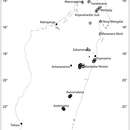Description
provided by Phytokeys
Shrubs or trees, 3–9 m tall; dbh 6–10 cm; bark of main bole unknown. Vegetative and reproductive parts glabrous or (as noted) moderately to densely sericeous (trichomes dibrachiate and ferrugineous). Branchlets somewhat compressed laterally but becoming terete, becoming irregularly wrinkled in age, oil glands common, prominent and somewhat protruding initially but fading with age, grayish brown. Leaves concentrated mostly at branchlet tips, only 1–2 leaves produced during seasonal growth, the pairs ca. 1–1.5 cm distant; blades coriaceous, venation brochidodromous, surface and margin flat or slightly sinuous, somewhat discolorous, matte above and below. Axillary colleters absent. Petioles 6.5–10.5 mm long, rounded above, eglandular, shedding an outer (grayish or light brownish) epidermal layer with age. Leaf blades (9)11.5–22 × (3.4)5–8.7 cm, elliptic (or infrequently narrowly elliptic, narrowly obovate or obovate), base cuneate, apex obtuse; adaxial surface oil gland dense, easily seen with magnification, midvein sulcate but becoming flush apically, secondary veins protruding slightly; abaxial surface sparsely to moderately sericeous (hairs dibrachiate, ferrugineous) but becoming glabrous, oil glands common (notably less dense than adaxial), midvein protruding (and with punctate glands, especially proximally), punctate, striate, secondary veins somewhat protruding (moreso than on adaxial surface), intramarginal vein connecting tips of secondaries arching moderately, 1.5–3.3 mm from margin at laminar midpoint. Inflorescence of terminal, axillary or ramiflorous monads, solitary to paired or occasionally in few-flowered fascicles. Pedicels 8–21 mm long (in fruit), 1.8–3.5 mm wide, round in transverse section, rigidly stiff, ascending, sparsely hairy (use high magnification) or evidently glabrous, eglandular, somewhat striate, the epidermis reddish and eventually cracking in small irregular flakes, anthopodia and metaxyphylls lacking. Bracteoles (only one seen) evidently broadly triangular, ca. 2 mm long. Calyx lobes 4, 5.5–8.8 mm long, broadly rounded, apex obtuse, hairy towards based but otherwise more or less glabrous adaxially, moderately to densely hairy abaxially, bifacially glandular, persisting in fruit and tearing somewhat beneath the based as fruit matures, green to cream-colored or magenta above. Petals violet (Ratolojanahary 88). Staminal disk (in mature fruit) 7–16 mm wide, glabrous. Stamens (estimated from basal scars) 150+. Style (material scant) ca. 9 mm long, glabrous; stigma narrow (scarcely if at all capitate). Ovary 2-locular; placentation axile; ovules up to 5 per locule and radiating from central position. Berries 3.2–4.1 × (1.6)2.4–5.0 cm, irregularly globose and often with 3-numerous irregular lobes (from maturing seeds), densely shortly sericeous, pale green immature becoming grayish-brown when fresh but drying light rusty-brown by virtue of indumentum, outer wall embedded with numerous straight, more or less evenly spaced vertical veins extending between base and apex. Seeds 3–15 per fruit (up to 8 per locule), 17–25 mm long, up to ca. 15 mm thick (shrinking considerably away from seed coat during drying), radiating out from placenta (narrowed towards attachment point); seed coat thickly membranous to somewhat leathery, eglandular, separating easily from embryo, surface drying irregularly bullate, light reddish brown; cotyledons evidently completely fused.
- license
- cc-by-3.0
- copyright
- Neil Snow, Martin Callmander, Peter B. Phillipson
- bibliographic citation
- Snow N, Callmander M, Phillipson P (2015) Studies of Malagasy Eugenia – IV: Seventeen new endemic species, a new combination, and three lectotypifications; with comments on distribution, ecological and evolutionary patterns PhytoKeys (49): 59–121
- author
- Neil Snow
- author
- Martin Callmander
- author
- Peter B. Phillipson
Distribution
provided by Phytokeys
Known from the eastern escarpment of Madagascar in Finarantsoa and Toamasina provinces around and in the Andringitra, Ranomafana and Analamazaotra Special Reserve (Fig. 11).
- license
- cc-by-3.0
- copyright
- Neil Snow, Martin Callmander, Peter B. Phillipson
- bibliographic citation
- Snow N, Callmander M, Phillipson P (2015) Studies of Malagasy Eugenia – IV: Seventeen new endemic species, a new combination, and three lectotypifications; with comments on distribution, ecological and evolutionary patterns PhytoKeys (49): 59–121
- author
- Neil Snow
- author
- Martin Callmander
- author
- Peter B. Phillipson

